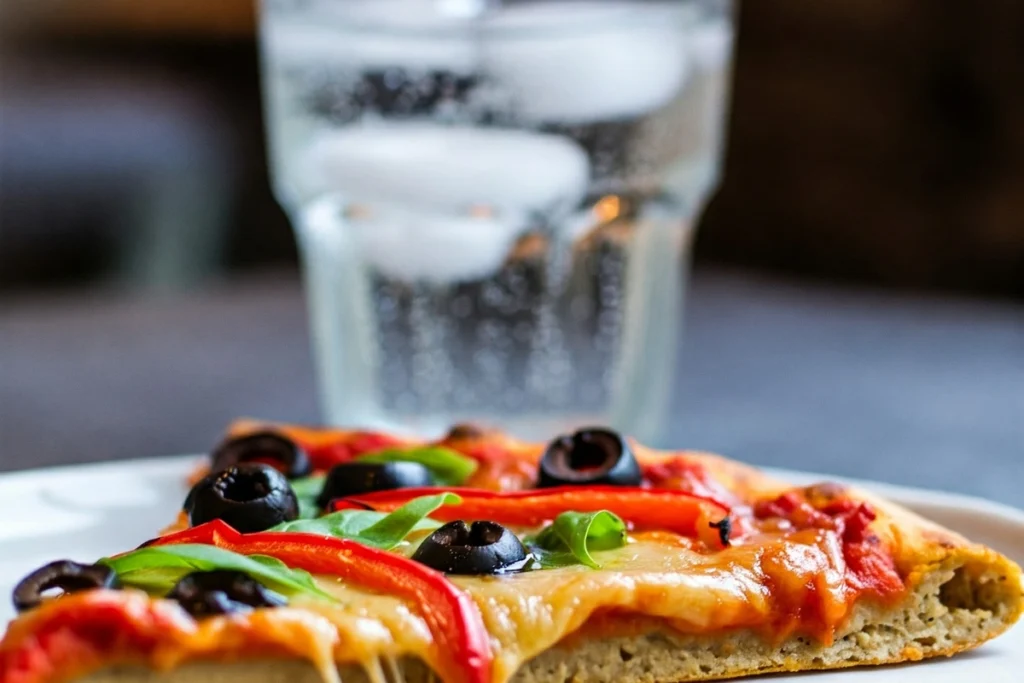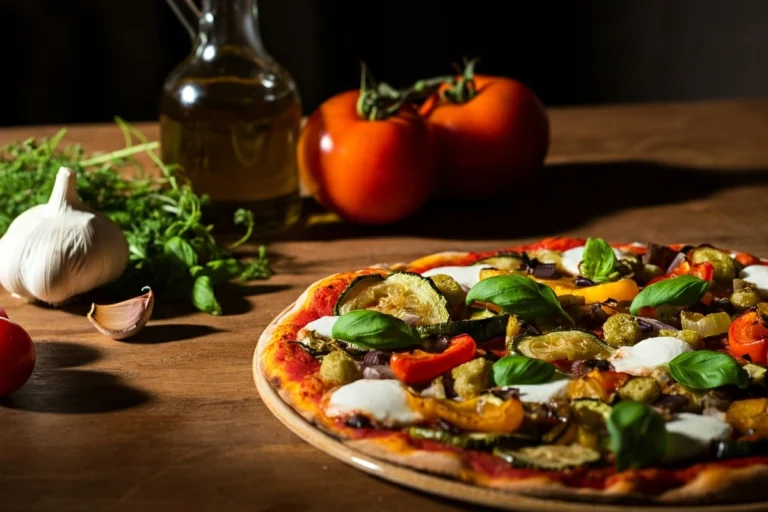Pizza is a universally loved dish, but not all pizzas are created equal. Enter vegan pizza—a plant-based delight that’s as versatile as it is delicious. In this guide, we’ll take you on a journey through the world of vegan pizza, from its origins to the best recipes, tips, and nutritional benefits. Whether you’re new to the concept or a seasoned vegan, there’s something here for everyone. Let’s get started!
Introduction to Vegan Pizza
What Is Vegan Pizza?
At its core, vegan pizza is a pizza made without any animal-derived ingredients. That means no dairy cheese, no meat toppings, and sometimes even no honey in the dough. Instead, it’s crafted with innovative plant-based alternatives like nut-based cheeses, seitan pepperoni, and fresh, colorful veggies. What’s amazing is that vegan pizzas can taste just as rich and indulgent as their traditional counterparts, all while being cruelty-free.
Why Choose Vegan Pizza?
Why are more people turning to vegan pizza? The reasons are as varied as the toppings. For starters, it’s a healthier choice. Swapping dairy cheese for plant-based options significantly reduces cholesterol and saturated fat. Plus, vegan pizza aligns with environmental sustainability—plant-based diets have a smaller carbon footprint compared to meat-heavy ones.
Then there’s the ethical factor. Many choose vegan pizza to support animal welfare, ensuring their meal is free from cruelty. And the best part? You don’t have to compromise on taste. From smoky barbecue jackfruit to creamy cashew mozzarella, vegan pizzas offer endless opportunities for culinary creativity.
Key Takeaway
Vegan pizza is more than just a diet choice—it’s a flavorful, ethical, and eco-friendly revolution. Whether you make it at home or grab one from your favorite pizzeria, vegan pizza proves that you can have your slice and eat it too!
History of Vegan Pizza
The Origins of Pizza and Its Evolution
Pizza has a long history, dating back to ancient times when flatbreads served as a canvas for various toppings. Originally, the idea of pizza came from Naples, Italy, where humble ingredients like tomatoes, cheese, and basil transformed simple dough into a culinary sensation. Over the years, pizza has evolved into countless variations, reflecting the creativity and preferences of diverse cultures.
When the global vegan movement began gaining momentum, vegan pizza emerged as an answer to the growing demand for plant-based alternatives. It paved the way for delicious innovation, replacing traditional ingredients like cheese and meat with vegan-friendly substitutes.
When and Why Vegan Pizza Was Created
Vegan pizza was born out of a desire to make this beloved dish accessible to everyone, including those avoiding animal products for ethical, environmental, or health reasons. Its creation aligned with the rise of dairy-free cheeses, which mimic the melt and texture of traditional cheese. By the early 2000s, vegan pizzas were becoming more mainstream, showing up in both restaurants and frozen food aisles.
This evolution isn’t just a trend—it’s a testament to how food culture adapts. Today, vegan pizza is a shining example of how innovation can turn a classic into something even more inclusive and sustainable.
Essential Ingredients for Vegan Pizza
Plant-Based Pizza Dough
The foundation of any good pizza is its crust. Luckily, most traditional pizza dough recipes are naturally vegan since they only require flour, yeast, water, salt, and olive oil. To add variety, you can use whole-grain or gluten-free flours for a healthier twist. For extra flavor, herbs like oregano or garlic powder can be mixed directly into the dough.
Dairy-Free Cheese Alternatives
Cheese often takes center stage on pizza, and the same holds true for vegan versions. Thanks to advancements in plant-based food technology, you’ll find dairy-free cheeses made from cashews, almonds, soy, or even tapioca starch. These alternatives melt beautifully and come in a range of flavors, from mozzarella to cheddar. Some popular brands include Violife, Daiya, and Miyoko’s Creamery.
Creative Vegan Toppings
Vegan pizza toppings are where creativity shines. From roasted vegetables and sun-dried tomatoes to more adventurous options like barbecue jackfruit or spicy chickpeas, the possibilities are endless. Don’t forget the garnishes—fresh basil, arugula, or a drizzle of balsamic glaze can elevate your pizza to gourmet status.
Step-by-Step Vegan Pizza Recipes
Classic Margherita Vegan Pizza Recipe
If you’re craving simplicity with a twist, a vegan Margherita pizza is your go-to option. Start with a vegan-friendly pizza dough, roll it out thin, and spread a layer of rich tomato sauce. Add dollops of plant-based mozzarella—such as one made from cashews or coconut oil—for that classic creamy texture. Top it with fresh basil leaves, drizzle with olive oil, and bake until the crust is golden and the cheese is melted.
Ingredients:
- Vegan pizza dough
- Tomato sauce
- Plant-based mozzarella
- Fresh basil
- Olive oil
This recipe is perfect for weeknights when you need something quick yet comforting.
BBQ Jackfruit Vegan Pizza Recipe
For a bold and smoky flavor, try a BBQ jackfruit pizza. Use tender jackfruit as a meat substitute—it absorbs the flavors of barbecue sauce beautifully. Spread a layer of barbecue sauce on the base, arrange the jackfruit, and add red onion slices, sweet corn, and a sprinkle of vegan cheddar. Bake and garnish with fresh cilantro or parsley for a burst of freshness.
Ingredients:
- Vegan pizza base
- Barbecue sauce
- Jackfruit (pre-shredded and cooked)
- Red onions
- Vegan cheddar
This recipe is a hit for gatherings and shows off just how versatile vegan pizza can be.
Gluten-Free Vegan Pizza Options
For those avoiding gluten, use a gluten-free pizza dough made from almond or rice flour. Pair it with your favorite vegan toppings, like spinach, mushrooms, and bell peppers. Finish with a drizzle of garlic-infused olive oil for an extra zing.

Tips for Perfect Vegan Pizza
Achieving the Perfect Vegan Cheese Melt
Getting vegan cheese to melt can be tricky, but not impossible. Many plant-based cheeses, like tapioca-based ones, melt best when covered slightly during baking. Try grating your cheese finely or adding a splash of non-dairy milk to make it even creamier.
Balancing Flavors and Textures
A great vegan pizza balances savory, sweet, and tangy flavors. Use a blend of roasted vegetables for depth, fresh greens for crispness, and a tangy tomato base. Don’t forget to season your crust with garlic or herb-infused olive oil for an extra punch of flavor.
Common Mistakes and How to Avoid Them
- Overloading Toppings: Too many toppings can make your pizza soggy. Stick to a few well-chosen ingredients.
- Ignoring the Crust: A well-cooked crust can make or break a pizza. Pre-bake your crust slightly for extra crispness.
For more recipe inspiration, explore Goldy Recipe’s pizza toppings guide for creative ideas that complement your vegan pizza creations!
Top Vegan Pizza Brands and Delivery Options
Best Frozen Options
Frozen vegan pizzas have come a long way, offering convenience without compromising flavor. Brands like Daiya and Amy’s Kitchen deliver pizzas loaded with creamy dairy-free cheeses and hearty plant-based toppings. These options are perfect for quick meals or lazy movie nights when you want a tasty treat with minimal effort.
When shopping, check labels for high-quality ingredients and unique flavor profiles. For instance, some frozen pizzas feature gluten-free crusts or bold toppings like pesto or vegan sausage. With so many options, it’s easy to stock your freezer with a variety of vegan pizza flavors.
Chains and Restaurants
The rise in popularity of vegan pizza has inspired many restaurants to adapt their menus. Chains like Blaze Pizza and MOD Pizza now offer vegan cheese and plant-based meat options, letting you build your pizza just the way you like. Popular local spots often have house-made vegan crusts and gourmet toppings like artichokes, roasted garlic, and balsamic drizzle.
For delivery, apps like Uber Eats and DoorDash allow you to filter options to find the best vegan pizzas nearby. Whether you’re dining out or staying in, you’re never far from a delicious slice.

Nutritional Benefits
Healthier Alternatives to Traditional Pizza
Vegan pizza is more than just a tasty alternative—it’s a healthier one too. By skipping animal products, you reduce saturated fats and cholesterol, making it a heart-friendly option. Plant-based cheeses, such as those made from cashews or almonds, are lower in calories while still providing a creamy texture.
Whole-grain or veggie-based crusts add fiber and nutrients, improving digestion and keeping you fuller for longer. Plus, the abundance of colorful veggie toppings means you’re getting a wealth of vitamins and antioxidants in every bite.
Nutritional Breakdown of Popular Vegan Pizzas
The nutritional content of vegan pizza depends on the ingredients, but most options are packed with benefits. A veggie-loaded pizza with tomato sauce, mushrooms, and spinach is rich in iron, vitamin C, and lycopene. Add some nutritional yeast or fortified vegan cheese, and you’ll get a good dose of vitamin B12 too.
Whether you’re looking to improve your diet or enjoy a more ethical meal, vegan pizza offers a guilt-free way to indulge while nourishing your body.
FAQs
What Are the Best Vegan Cheese Brands for Pizza?
Choosing the right vegan cheese can make or break your pizza experience. Some popular options include Miyoko’s Creamery for its creamy texture and Violife for its versatile meltability. If you’re making pizza at home, try a mix of shredded and sliced cheeses to achieve the perfect gooey effect. These brands have become staples for many because they closely replicate the taste and texture of traditional cheese.
Can Gluten-Free Pizza Be Vegan Too?
Absolutely! Many gluten-free crusts, such as those made from almond flour or cauliflower, are naturally vegan. When ordering or making a gluten-free vegan pizza, check that the toppings and cheese alternatives are plant-based. Most pizzerias now offer options that cater to both dietary needs, making it easier than ever to enjoy a slice without compromising.
How to Ensure Vegan Pizza Is Nut-Free?
If you’re avoiding nuts, look for vegan cheeses made from soy, rice, or coconut. Many brands clearly label their products as nut-free, so you can enjoy a safe and delicious vegan pizza. For homemade options, nutritional yeast is a great alternative to achieve a cheesy flavor without using nuts.
Conclusion
As plant-based eating continues to rise, vegan pizza has become a symbol of innovation in the food world. It’s no longer just for vegans—more people are choosing it for health benefits, environmental reasons, and its exciting flavors. Restaurants and brands are expanding their vegan offerings, proving that this trend is here to stay.
What’s not to love about vegan pizza? It’s inclusive, customizable, and delicious. Whether you’re a lifelong vegan or just curious about plant-based options, trying a vegan pizza can open up a whole new world of culinary possibilities. From bold flavors to health-conscious ingredients, vegan pizza embodies the best of modern food culture.
In conclusion, vegan pizza isn’t just food—it’s a movement. It challenges the norms, delights the senses, and aligns with a more sustainable future. So next time you’re craving pizza, why not try the vegan version? You might just discover your new favorite slice!

